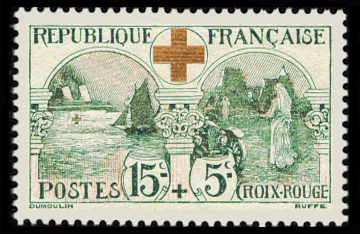TIMBRES DE FRANCE
Ex : 50 c
Ex : 456
Ex : Appel du 18 juin
Ex : 1900
Ex : Femme
mini 4 lettres
Création du site : Juillet 2005
Nombre de visiteurs : 31.262.791
Nombre de pages : 107.240.254
Dernière mise à jour 18-11-2024
Nombre de visiteurs : 31.262.791
Nombre de pages : 107.240.254
Dernière mise à jour 18-11-2024
Cette bannière est une publicité le site n'a aucune boutique de vente
Les informations sur ce timbre ont été mises à jour le : 16/10/2024

Croix-Rouge française
Timbre : Courant / moderne
Voir tous les timbres courants de l'année 1918
Listage des timbres de l'année 1918
Vente générale : 8 aout 1918
Retrait de la vente : 1 avril 1921
Valeur faciale : 15 c + 5 c
Graveur : Léon Henri Ruffé
Dessinateur : Louis Dumoulin
Dentelure : 13½ x 14
Couleur : noir et rouge
Mode d'impression : Typographie
Format du timbre : 40 x 24 mm
Quantité émis : Pas d'information fiable
Présentation : Feuille de 75 timbres
Bande phosphore : Sans
Catalogue Yvert et Tellier France : N° 156
Catalogue Spink / Maury France : N° 156
Catalogue Michel : N° FR 136
Catalogue Scott : N° FR B11
Valeur marchande timbre neuf avec gomme intacte: 75,00 €
Valeur marchande timbre neuf avec charnière : 35,00 €
Valeur marchande timbre oblitéré : 17,50 €
La valeur marchande représente une valeur de base du timbre pour la vente ou l'échange
Thématique catégorie : Croix Rouge
Informations sur le sujet du timbre
 Henri Dunant (Image Wikipédia)
Henri Dunant (Image Wikipédia)
Henri Dunant
né le 8 mai 1828, à Genève et mort le 30 octobre 1910, à Heiden, est un homme d'affaires humaniste suisse et également un chrétien protestant. Naturalisé français en avril 1859, il a fondé la Croix-Rouge.Pendant un voyage d'affaires en juin 1859, il se trouve à proximité de la ville italienne de Solférino et découvre les dégâts humains de la bataille qui s’y déroula. À partir de cette expérience, il écrit un livre intitulé «Un souvenir de Solférino» qu'il publie en 1862.
Une année plus tard, il participe à Genève à la fondation du Comité international de secours aux militaires blessés, désigné dès 1876 sous le nom de Comité international de la Croix-Rouge. La première convention de Genève est ratifiée en 1864 et se réfère largement à ses propositions. Il obtient avec Frédéric Passy le premier prix Nobel de la paix en 1901 et est ainsi considéré comme le fondateur du mouvement de la Croix-Rouge internationale
Source Wikipédia
Henri Dunant
born 8 May 1828 in Geneva and died 30 October 1910 in Heiden, was a Swiss humanist businessman and also a Protestant Christian. Naturalized French in April 1859, he founded the Red Cross.During a business trip in June 1859, he was near the Italian town of Solferino and discovered the human damage of the battle that took place there. From this experience, he wrote a book entitled «A Memory of Solférino» which he published in 1862.
One year later, he participated in the founding of the International Committee for the Relief of Wounded Soldiers in Geneva, which was designated as the International Committee of the Red Cross in 1876. The first Geneva Convention was ratified in 1864 and largely refers to its proposals. He and Frédéric Passy won the first Nobel Peace Prize in 1901, and is thus considered to be the founder of the international Red Cross movement
Source Wikipedia
Cette page a été visitée 12 004 700 fois depuis le 1er mai 2022
